Abstract
Water samples were collected from four locations on two rivers in Washington State and analyzed by membrane filtration-immunofluorescence assay to establish Cryptosporidium oocyst concentrations. Sampling locations were selected to evaluate effects of watershed character, from pristine mountain to downstream agricultural, on oocyst concentrations. Samples were collected at six biweekly intervals from late June to early September, with two additional sets of five samples taken on separate days (one set taken at bihourly intervals and one set taken simultaneously). Cryptosporidium oocysts were found in 34 of 35 samples at concentrations ranging from about 0.2 to 65 oocysts per liter. Oocyst concentrations were highest early in the sampling period, when they were influenced by postrainfall runoff, and decreased through the summer months. Oocyst concentrations found in ten samples collected on two days (5 samples per day) showed no short-term variations. Oocyst concentrations and oocyst production per square mile (ca. 2.6 km2) of watershed found in water draining a controlled public water supply watershed were the lowest observed. The concentrations and production rates for drainage from an adjacent, comparable, but uncontrolled watershed were nearly 10 times higher. The concentration and production rates of the downstream area influenced by dairy farming were nearly 10 times higher than rates at the upstream stations. The data showed clearly that oocyst concentrations were consistently observed above the detection limit of the analytical method, about 0.1 oocysts per liter; that oocyst concentrations were continuous as opposed to intermittent; and that watershed character and management affected surface water oocyst concentrations significantly.
Full text
PDF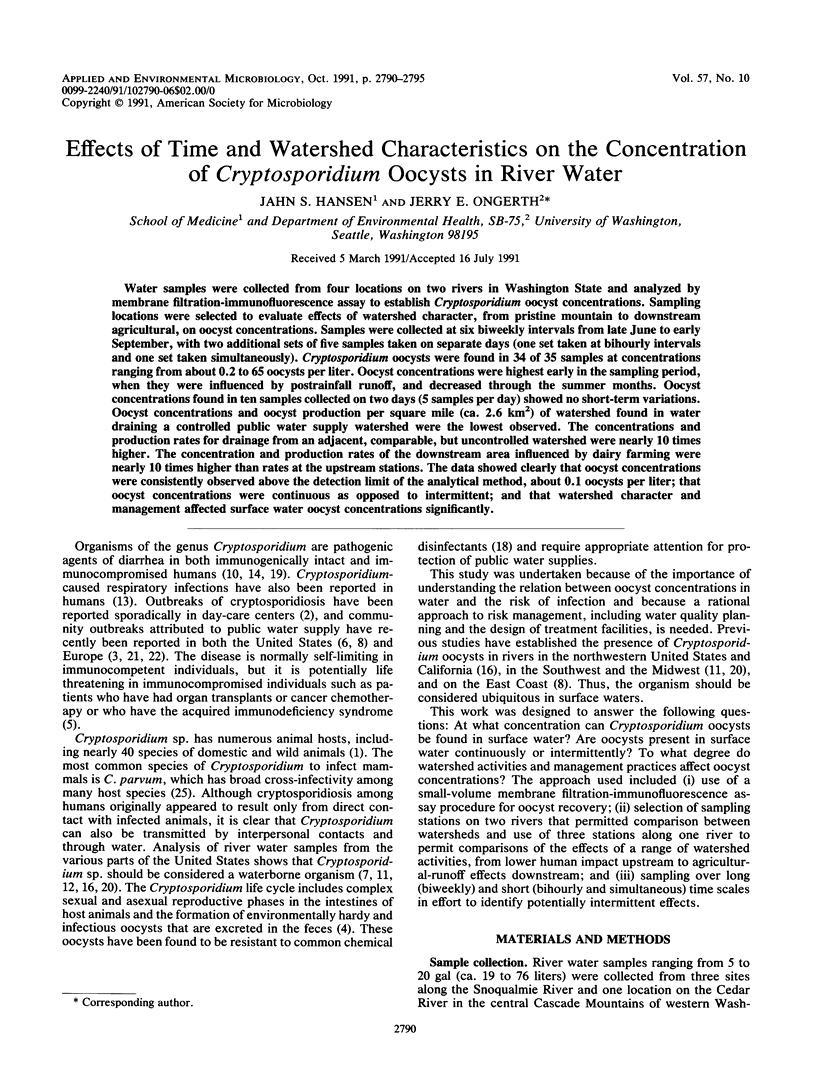
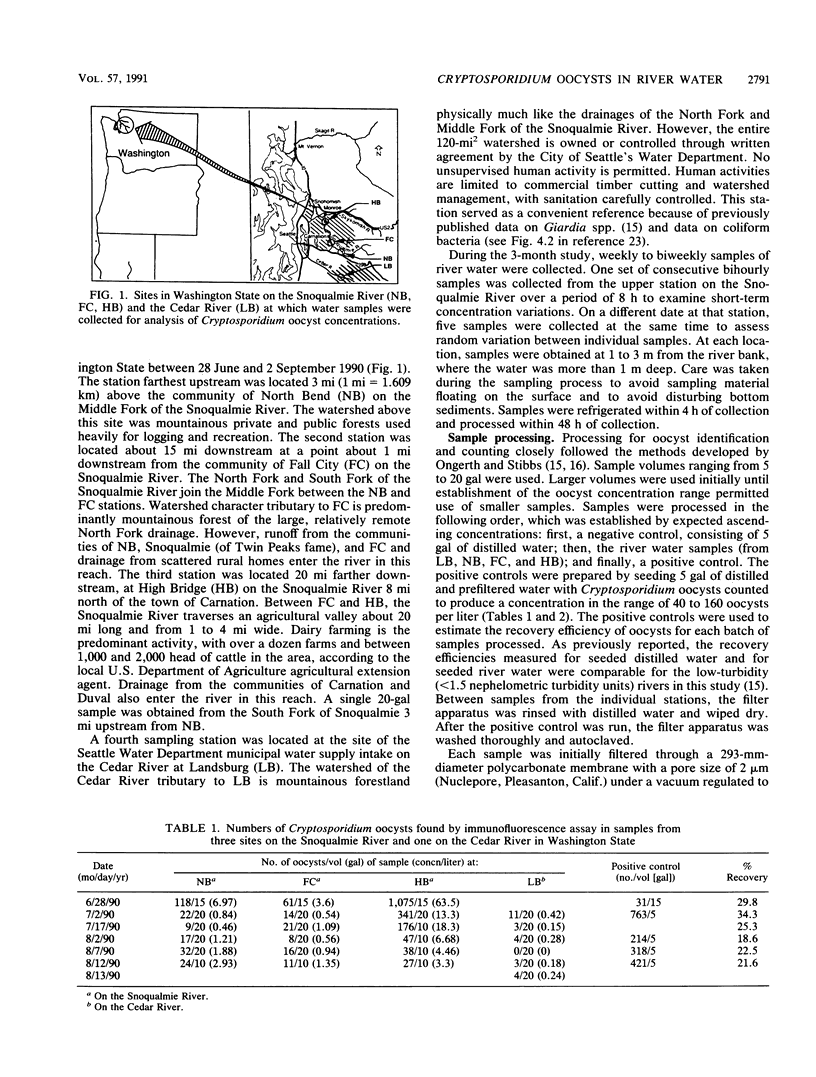
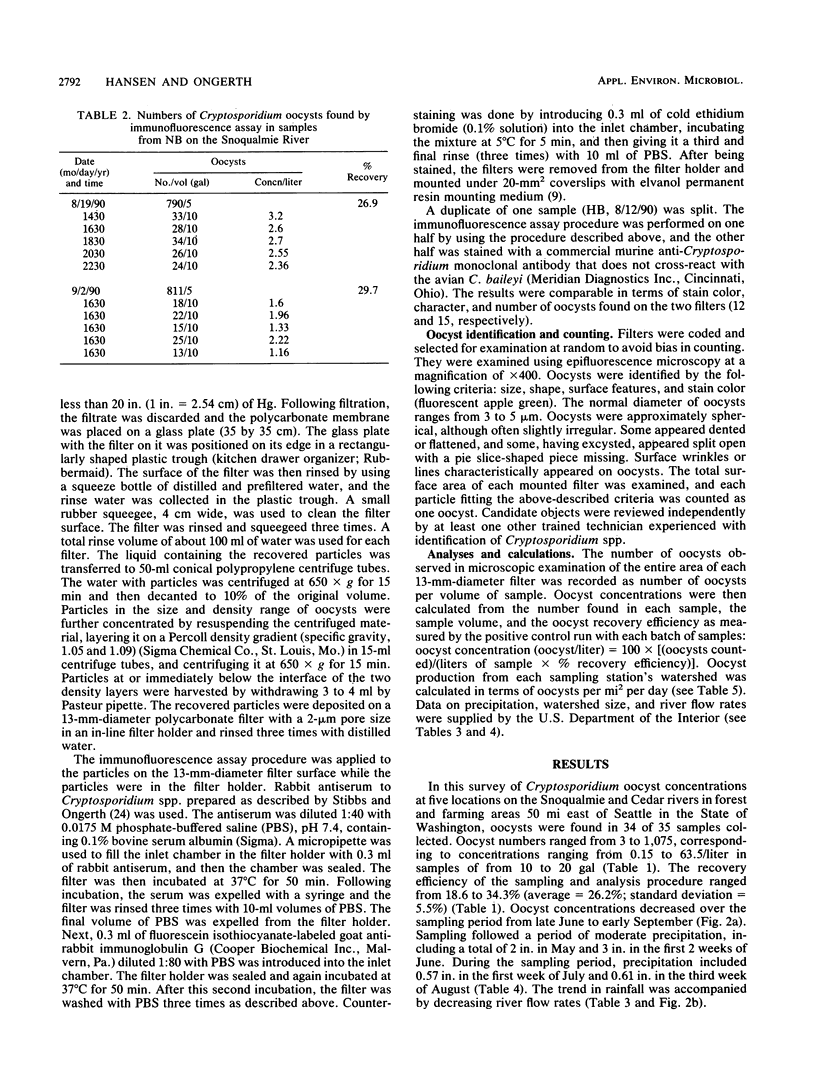
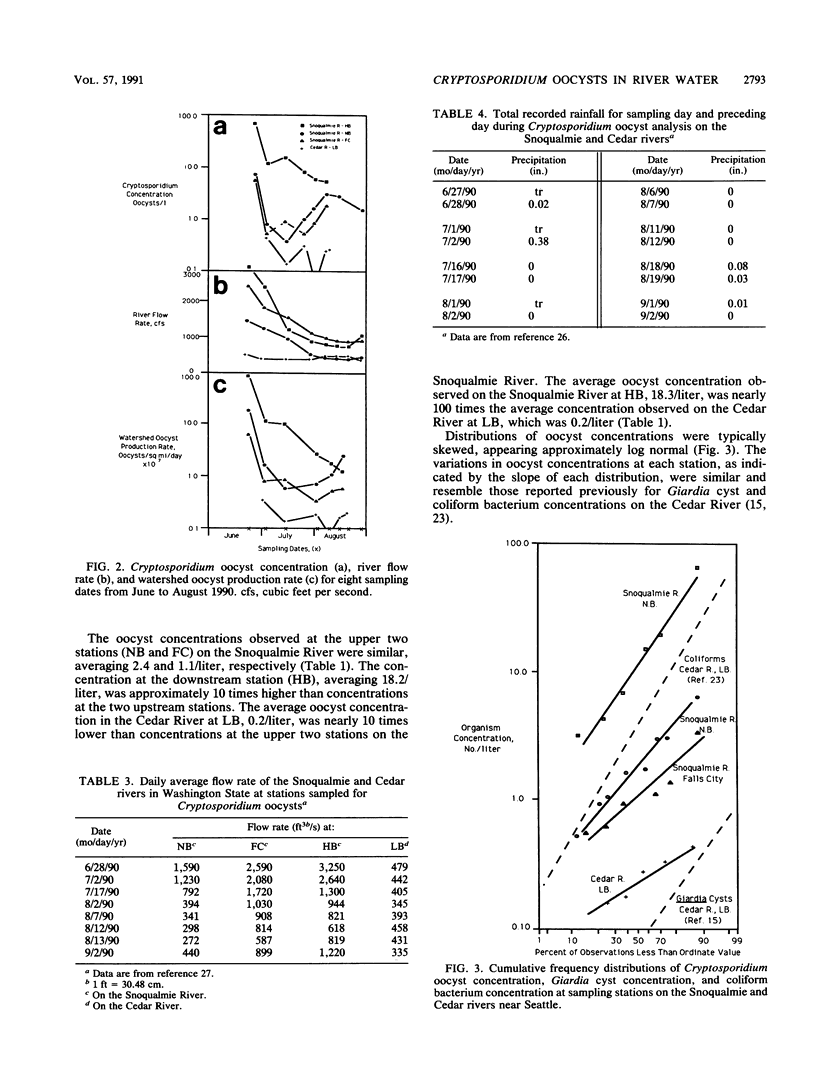
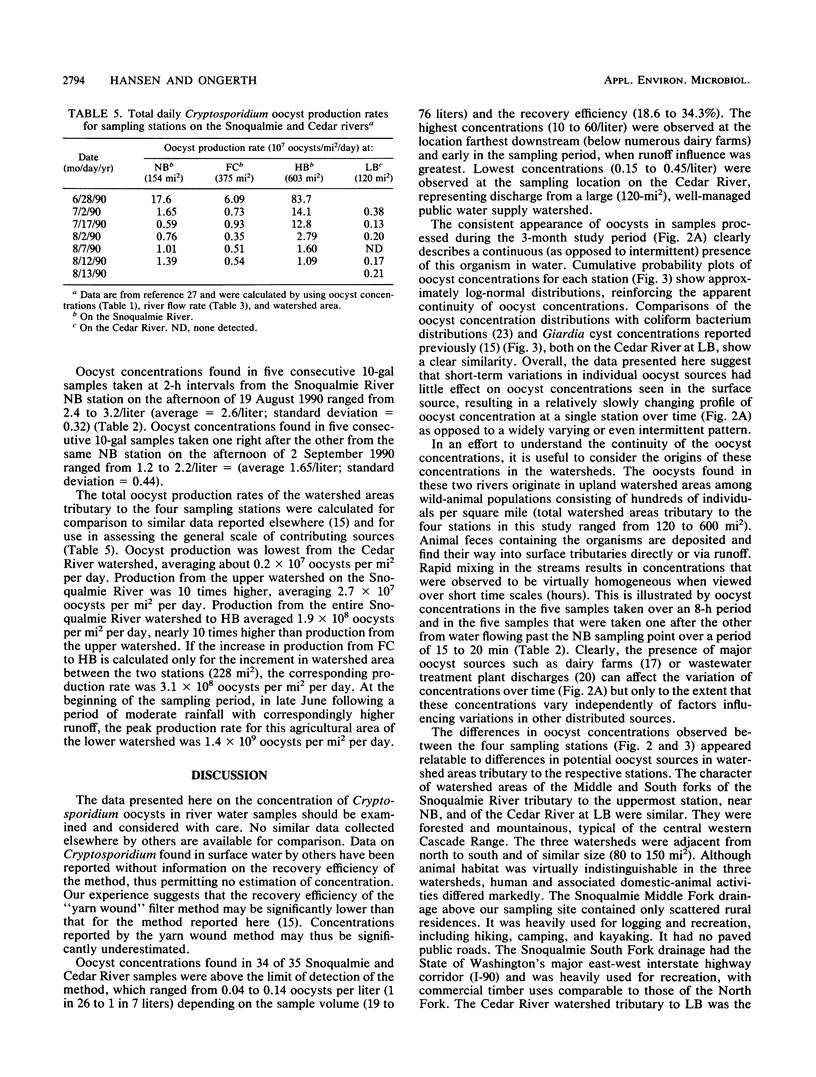
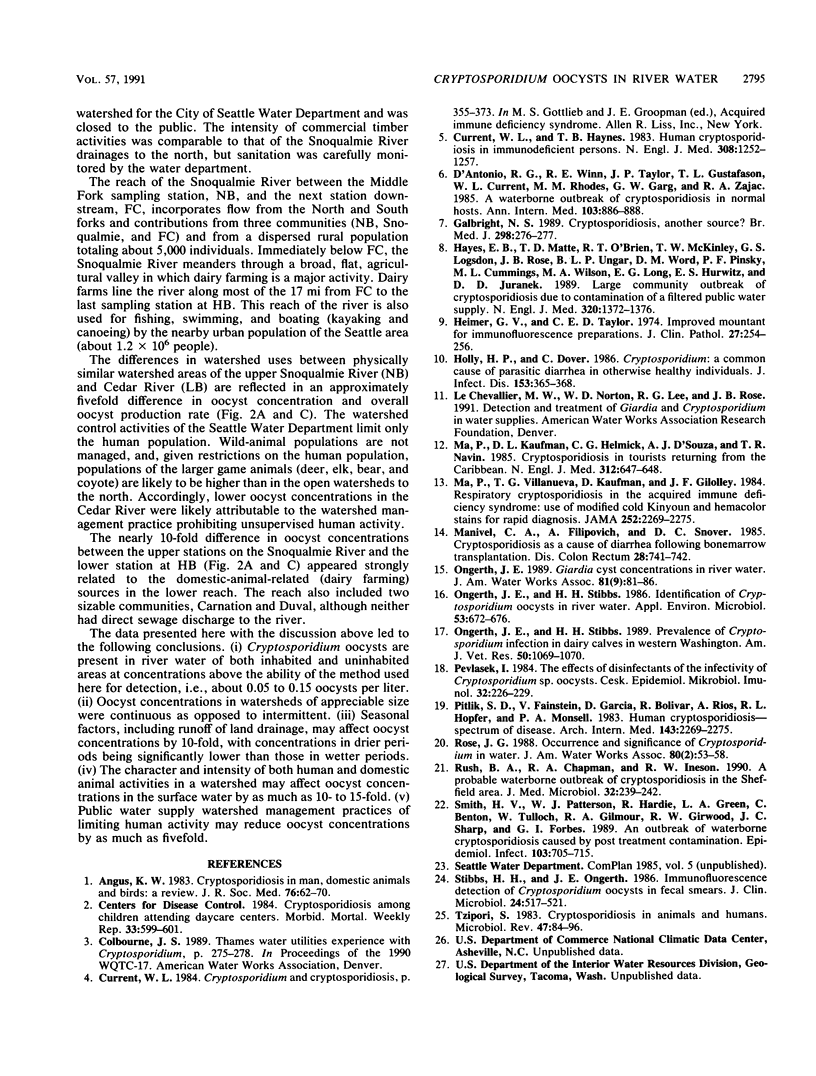
Selected References
These references are in PubMed. This may not be the complete list of references from this article.
- Angus K. W. Cryptosporidiosis in man, domestic animals and birds: a review. J R Soc Med. 1983 Jan;76(1):62–70. doi: 10.1177/014107688307600114. [DOI] [PMC free article] [PubMed] [Google Scholar]
- Current W. L., Reese N. C., Ernst J. V., Bailey W. S., Heyman M. B., Weinstein W. M. Human cryptosporidiosis in immunocompetent and immunodeficient persons. Studies of an outbreak and experimental transmission. N Engl J Med. 1983 May 26;308(21):1252–1257. doi: 10.1056/NEJM198305263082102. [DOI] [PubMed] [Google Scholar]
- D'Antonio R. G., Winn R. E., Taylor J. P., Gustafson T. L., Current W. L., Rhodes M. M., Gary G. W., Jr, Zajac R. A. A waterborne outbreak of cryptosporidiosis in normal hosts. Ann Intern Med. 1985 Dec;103(6 ):886–888. doi: 10.7326/0003-4819-103-6-886. [DOI] [PubMed] [Google Scholar]
- Hayes E. B., Matte T. D., O'Brien T. R., McKinley T. W., Logsdon G. S., Rose J. B., Ungar B. L., Word D. M., Pinsky P. F., Cummings M. L. Large community outbreak of cryptosporidiosis due to contamination of a filtered public water supply. N Engl J Med. 1989 May 25;320(21):1372–1376. doi: 10.1056/NEJM198905253202103. [DOI] [PubMed] [Google Scholar]
- Heimer G. V., Taylor C. E. Improved mountant for immunofluorescence preparations. J Clin Pathol. 1974 Mar;27(3):254–256. doi: 10.1136/jcp.27.3.254. [DOI] [PMC free article] [PubMed] [Google Scholar]
- Holley H. P., Jr, Dover C. Cryptosporidium: a common cause of parasitic diarrhea in otherwise healthy individuals. J Infect Dis. 1986 Feb;153(2):365–368. doi: 10.1093/infdis/153.2.365. [DOI] [PubMed] [Google Scholar]
- Ma P., Kaufman D. L., Helmick C. G., D'Souza A. J., Navin T. R. Cryptosporidiosis in tourists returning from the Caribbean. N Engl J Med. 1985 Mar 7;312(10):647–648. doi: 10.1056/nejm198503073121011. [DOI] [PubMed] [Google Scholar]
- Manivel C., Filipovich A., Snover D. C. Cryptosporidiosis as a cause of diarrhea following bone marrow transplantation. Dis Colon Rectum. 1985 Oct;28(10):741–742. doi: 10.1007/BF02560294. [DOI] [PubMed] [Google Scholar]
- Ongerth J. E., Stibbs H. H. Identification of Cryptosporidium oocysts in river water. Appl Environ Microbiol. 1987 Apr;53(4):672–676. doi: 10.1128/aem.53.4.672-676.1987. [DOI] [PMC free article] [PubMed] [Google Scholar]
- Ongerth J. E., Stibbs H. H. Prevalence of Cryptosporidium infection in dairy calves in western Washington. Am J Vet Res. 1989 Jul;50(7):1069–1070. [PubMed] [Google Scholar]
- Pitlik S. D., Fainstein V., Garza D., Guarda L., Bolivar R., Rios A., Hopfer R. L., Mansell P. A. Human cryptosporidiosis: spectrum of disease. Report of six cases and review of the literature. Arch Intern Med. 1983 Dec;143(12):2269–2275. doi: 10.1001/archinte.1983.00350120059015. [DOI] [PubMed] [Google Scholar]
- Rush B. A., Chapman P. A., Ineson R. W. A probable waterborne outbreak of cryptosporidiosis in the Sheffield area. J Med Microbiol. 1990 Aug;32(4):239–242. doi: 10.1099/00222615-32-4-239. [DOI] [PubMed] [Google Scholar]
- Smith H. V., Patterson W. J., Hardie R., Greene L. A., Benton C., Tulloch W., Gilmour R. A., Girdwood R. W., Sharp J. C., Forbes G. I. An outbreak of waterborne cryptosporidiosis caused by post-treatment contamination. Epidemiol Infect. 1989 Dec;103(3):703–715. doi: 10.1017/s0950268800031101. [DOI] [PMC free article] [PubMed] [Google Scholar]
- Stibbs H. H., Ongerth J. E. Immunofluorescence detection of Cryptosporidium oocysts in fecal smears. J Clin Microbiol. 1986 Oct;24(4):517–521. doi: 10.1128/jcm.24.4.517-521.1986. [DOI] [PMC free article] [PubMed] [Google Scholar]
- Tzipori S. Cryptosporidiosis in animals and humans. Microbiol Rev. 1983 Mar;47(1):84–96. doi: 10.1128/mr.47.1.84-96.1983. [DOI] [PMC free article] [PubMed] [Google Scholar]


